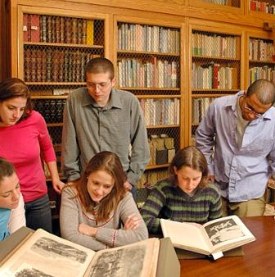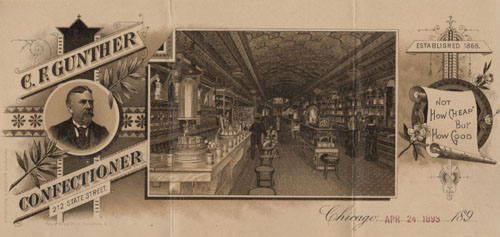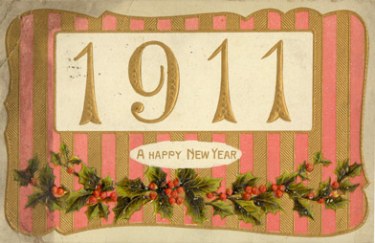From the James Southgate Papers, 1794-1944 and undated, bulk 1851-1935.
Office of Clara Barton
Letterhead from two letters (March 3, 1881 and November 13, 1882, respectively) from Clara Barton to her friend Mary Norton. From the Mary Norton Papers, 1852-1895.
(NB: The letter with the Dansville, NY letterhead was actually written in Washington, D.C. The letter with the Washington, D.C. letterhead was actually written in Dansville, NY.)
Rights! Camera! Action! Spring 2011 Season
The third season of the popular Rights! Camera! Action! film series begins tomorrow evening with Citizen King, which traces the final five years of Dr. Martin Luther King, Jr’s life, starting with his momentous 1963 “I Have a Dream” speech.
We’ll provide free drinks and popcorn, as well as a panel discussion following the film!
The Rights! Camera! Action! film series, which is sponsored by the Archive for Human Rights, the Archive of Documentary Arts, the Duke Human Rights Center, the Franklin Humanities Institute, and Screen/Society at Duke’s Arts of the Moving Image Program, features documentaries on human rights themes that were award winners at the annual Full Frame Documentary Film Festival. The films are archived at the RBMSCL, where they form part of a rich and expanding collection of human rights materials.
For more about Rights! Camera! Action!’s Spring 2011 season, as well as details about tomorrow’s screening, click below.
Imperial Guano
It’s National Letter Writing Week—and the RBMSCL has no shortage of letters, be they handwritten, typed, telegraphed, or e-mailed. We’re going to celebrate with some great examples of letterhead from our collections!
From the A. J. Parker and Benjamin J. Parker papers, 1840-1895 and undated.
The Centennial of a Fire

100 years ago today, near tragedy struck campus as fire destroyed the Washington Duke Building, one of the seven original buildings constructed after the college moved from Randolph County to Durham. The multi-purpose building held lecture halls and offices, as well 56 dorm rooms. With coal heating and rooms lit by candle and kerosene lamp, the returning students must have tried to heat up the building too quickly that cold January 4th. Fortunately, all escaped uninjured.
Plans were already in place to replace the building and the new West Duke Building had just been completed. East Duke Building would be completed the following year on roughly the same spot as the original Washington Duke Building.

Additional Resources:
- Duke Magazine “Retrospective” about the fire by Duke University Archivist Tim Pyatt.
- A first-hand account of the fire by L. M. Epps, Class of 1912.
- The original idea for replacing the building.
Post contributed by Tim Pyatt, Duke University Archivist.
Happy 2011!
The End of an Ironclad Mystery?

The Battle of Hampton Roads, fought on March 9, 1862, marks the first time two ironclads engaged in battle: the USS Monitor and the CSS Virginia (formerly the USS Merrimack). While both warships escaped destruction that day, neither would survive the year intact. The CSS Virginia was destroyed by the Confederacy in May rather than risk its capture by Union forces. On December 31st, the USS Monitor sank off the coast of Cape Hatteras, North Carolina during a heavy storm. Duke University has ties to both.
In 1973, John G. Newton, Marine Superintendent for the Duke University Marine Laboratory, led a team that discovered the wreckage of the Monitor. Artifacts recovered from the site are currently on display at the Mariners’ Museum in Newport News, Virginia. However, the Duke University Archives might have a piece of the Virginia/Merrimack in its possession.

Earlier this year, the University Archives curated “‘As Far As Possible from Forgetfulness’: The Trinity College Historical Society.” Precursor to the University Archives, the Society was established in 1892, with the objective of collecting material illustrative of the history of North Carolina and the South. The exhibit included artifacts and documents that once belonged to the Society. One of the most popular pieces displayed was a non-descript piece of wood. My co-curators and I found no mention of this item’s identity or significance in the Society’s records, yet we felt strongly that the piece of wood should be included in the exhibit: at some point in the history of the Society, someone believed that piece of wood had historical significance.
On the day of the gallery talk on the exhibit, I delved deeper into resources available in the University Archives in hopes of uncovering any tidbits on the piece of wood. In the Christian Educator (a predecessor, in some respects, to the Chronicle), I found a reference to two pieces of wood donated to the Society in 1896. One was said to be from Libby Prison in Richmond and the other was said to be from the CSS Virginia/USS Merrimack. I mentioned these references at the gallery talk and also stated that a RBMSCL colleague with a background in archaeology noted the piece of wood appeared to have been in water at some point, leading me to speculate that this particular piece of wood might be from the ironclad.
Professor Emeritus of Botany and former director of the Sarah P. Duke Gardens Richard White attended the gallery talk and graciously offered to submit a sample of the piece of wood to a lab in Wisconsin that could potentially identify its species. We were able to obtain a loose sample from the artifact which was then submitted to the Center for Wood Anatomy Research for testing. The lab determined the wood to be of the white oak group.
Further research shows that white oak was often used in the construction of Civil War ironclads, including the Virginia/Merrimack. Is it possible that the mystery of the piece of wood’s identity and significance has been solved?
Post contributed by Kim Sims, Technical Services Archivist for the Duke University Archives.
Instruction-a-Go-Go
 This past semester, RBMSCL librarians led over 90 instruction sessions with students from Duke University and beyond—including students taking courses on advertising history at Elon University and Johnson & Wales University. We’ve pulled together a mere sampling of the courses we’ve supported over the past few months. We think you’ll see that the RBMSCL has something for every research interest!
This past semester, RBMSCL librarians led over 90 instruction sessions with students from Duke University and beyond—including students taking courses on advertising history at Elon University and Johnson & Wales University. We’ve pulled together a mere sampling of the courses we’ve supported over the past few months. We think you’ll see that the RBMSCL has something for every research interest!
- Advertising in Society
- The Age of Jim Crow: Racial Segregation from Plessy to Brown
- African American Women and History
- American Business History
- Animals and Ethics: Welfare, Rights, Utilitarianism, and Beyond
- Book Art: Text as Image (videos produced by students in the class)
- Citizen Organizing, 1776-Present
- Classics of American Literature, 1860 to1915
- Consumerism in Great Britain and the U.S.
- Documenting Race, Class, and Gender (Writing 20)
- Enlightenment Orientalism
- Globalization in Writing (Writing 20)
- Hidden Children: Children and Childhood in U.S. History and Across Cultures Cultures (Writing 20)
- History of Photography, 1839 to the Present
- Human Rights Activism
- Intermediate German Conversation
- Introduction to German Literature
- Introduction to Old English
- Methods of Social Research
- Native American History through Autobiography
- New Media, Memory, and the Visual Archive
- New Testament Greek Reading
- Photography in Context: Photographic Meaning and the Archive of Documentary Arts
- The Politics and Obligations of Memory
- Reading Gender, Writing Technoscience (Writing 20)
- Southern History
- Witchcraft in Comparative Perspective
- Writing Sound and Sound Writing: Hearing Race (Writing 20)
- Writing the Self (Writing 20)
Wondering if the RBMSCL could support your Spring 2011 course? Send us an e-mail at special-collections(at)duke.edu!
Book + Art = You!
As this semester winds down, don’t just hit the books. Make one!
For the conclusion of this semester’s Book + Art festival, undergraduate students from Duke University and the University of North Carolina at Chapel Hill are invited to participate in a juried exhibition of student artists’ books, to be held at UNC-Chapel Hill’s Hanes Art Center. Works selected for the exhibition will be displayed in the John and June Allcott Undergraduate Gallery at UNC’s Hanes Art Center. From the works selected for exhibition, one will be awarded best-in-show honors.
Rules
- The exhibit is open to undergraduate students from Duke University and UNC-Chapel Hill.
- All entries must be original work by the artist.
- There is no entry fee.
- Limit three entries per person.
- Completed entries are due by Dec. 17th, 2010.
You’ll find instructions on submitting your work at the student exhibition’s website.
Or, if you’re in need of some inspiration, visit the Duke University Libraries’ YouTube channel to see students from Merrill Shatzman’s “Book Art: Text as Image” class discussing artists’ books from the Bingham Center‘s collection.
[youtube=http://www.youtube.com/watch?v=wutd4Prn20s]
Human Rights Records, Electronically
 I’m a history Ph.D. candidate, so I knew something about working in archives when I started my internship with Technical Services at Duke’s Rare Book, Manuscript, and Special Collections Library (RBMSCL), but not a lot about processing paper records, never mind electronic ones. However, as I started processing several collections acquired through the Archive for Human Rights, I discovered that electronic files were often just as important to the collection as paper ones. When I started working on the Common Sense Foundation Papers, I faced over 16,000 electronic files in addition to 34 boxes of paper records! A North Carolina think-tank active from 1994 to 2008, the Common Sense Foundation (CSF) worked on initiatives such as the death penalty, testing in public schools, and LGBTQ rights.
I’m a history Ph.D. candidate, so I knew something about working in archives when I started my internship with Technical Services at Duke’s Rare Book, Manuscript, and Special Collections Library (RBMSCL), but not a lot about processing paper records, never mind electronic ones. However, as I started processing several collections acquired through the Archive for Human Rights, I discovered that electronic files were often just as important to the collection as paper ones. When I started working on the Common Sense Foundation Papers, I faced over 16,000 electronic files in addition to 34 boxes of paper records! A North Carolina think-tank active from 1994 to 2008, the Common Sense Foundation (CSF) worked on initiatives such as the death penalty, testing in public schools, and LGBTQ rights.
When I met with Paula Jeannet Mangiafico (Senior Processing Archivist), Seth Shaw (Electronic Records Archivist), and Patrick Stawski (Human Rights Archivist) to discuss the collection, we decided to integrate the electronic and paper files in the finding aid since the content overlapped and the volume was about equal. A researcher interested in the death penalty will thus find both electronic and paper records described in the Criminal Justice Subseries, which contains letters written by incarcerated people, a survey of capital defense lawyers, research on specific death-row inmates, and documents reflecting the daily work that occurred in CSF’s office surrounding this policy initiative.
Just as when working with paper documents, I screened the electronic files for sensitive information, such as personal, financial, and medical records. I then used the original path of the networked drive to describe the electronic files in the finding aid and used both the number of files and the megabyte size to indicate the physical extent. That way, researchers interested in a particular aspect of CSF’s work will know which electronic folders to request from RBMSCL staff, just as they would request a physical box by its number.
The RBMSCL has acquired almost 200 collections with electronic records in the past few years. Hopefully, my work with the CSF Papers will serve as model for processing future collections with strong electronic components.
Post contributed by Liz Shesko, Technical Services Processing Intern.
The Common Sense Foundation Papers are currently being processed. The finding aid will be published and the collection will be available for use in January 2011. For more information, contact the RBMSCL at special-collections(at)duke.edu.







